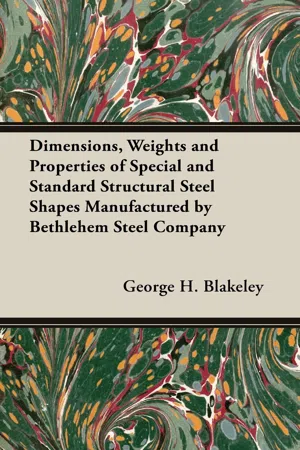
eBook - ePub
Dimensions, Weights and Properties of Special and Standard Structural Steel Shapes Manufactured by Bethlehem Steel Company
George H. Blakeley
This is a test
- 324 pages
- English
- ePUB (mobile friendly)
- Available on iOS & Android
eBook - ePub
Dimensions, Weights and Properties of Special and Standard Structural Steel Shapes Manufactured by Bethlehem Steel Company
George H. Blakeley
Book details
Book preview
Table of contents
Citations
About This Book
This early work on steel manufacturing is both expensive and hard to find in its first edition. It contains a comprehensive account of the specifications of products manufactured by the Bethlehem Steel Company. This is a fascinating work and is thoroughly recommended for anyone with an interest in the history of the steel industry. Many of the earliest books, particularly those dating back to the 1900s and before, are now extremely scarce. We are republishing these classic works in affordable, high quality, modern editions, using the original text and artwork.
Frequently asked questions
At the moment all of our mobile-responsive ePub books are available to download via the app. Most of our PDFs are also available to download and we're working on making the final remaining ones downloadable now. Learn more here.
Both plans give you full access to the library and all of Perlego’s features. The only differences are the price and subscription period: With the annual plan you’ll save around 30% compared to 12 months on the monthly plan.
We are an online textbook subscription service, where you can get access to an entire online library for less than the price of a single book per month. With over 1 million books across 1000+ topics, we’ve got you covered! Learn more here.
Look out for the read-aloud symbol on your next book to see if you can listen to it. The read-aloud tool reads text aloud for you, highlighting the text as it is being read. You can pause it, speed it up and slow it down. Learn more here.
Yes, you can access Dimensions, Weights and Properties of Special and Standard Structural Steel Shapes Manufactured by Bethlehem Steel Company by George H. Blakeley in PDF and/or ePUB format, as well as other popular books in Technology & Engineering & Engineering General. We have over one million books available in our catalogue for you to explore.
Information
PART I

SPECIAL
STRUCTURAL STEEL SHAPES
MANUFACTURED BY
BETHLEHEM STEEL COMPANY

BETHLEHEM
SPECIAL STRUCTURAL SHAPES.

The Bethlehem special structural shapes are wide flange I beam sections rolled by the Grey Universal Beam Mill. Instead of the horizontal grooved rolls of the ordinary beam mill, the Grey mill has horizontal and vertical rolls, by which the flanges and web of an I beam shape are each produced by combined rolling operations acting at right angles. This method of rolling makes it possible to obtain wider flanges than can be produced by the ordinary beam mill, where the web is the only part of the shape subjected to a true rolling operation and where the flanges are formed by the crowding or dragging of the metal through the flange grooves.
Wide flange beams from 10 inches to 30 inches deep, with flanges from 10 inches to 12 inches wide, have been rolled successfully for the past five years in Germany by this method. Such sections in regard to their shape and properties of strength present great advantages for structural work not obtainable with beams of the existing standard shapes. The wide flange beams can be used instead of riveted or built up sections for a variety of purposes with an economy in the weight of material, or with a saving in the labor and cost of punching, assembling and riveting, and in many cases with a saving of both material and labor.
Sections produced by this improved method have a uniform amount of work, or reduction, in the rolling on all parts of the shape, which is not the case in beams of I shape rolled by the ordinary mill. Especially the larger sizes of I beams rolled by the usual method show a great variation between the quality of the material in the webs and flanges, due to the difference in work of reduction of the metal during rolling. Such differences in quality of material between various parts of the section indicate a condition of internal stress existing in the metal caused by unequal deformation during the rolling process. Beams of all shapes and sizes rolled by the Grey mill have a uniformity in strength of material throughout the section, indicating not only an equal amount of work of reduction in the rolling without unequal deformation, but also the absence of internal stress in consequence: they are therefore safer and more reliable for any purpose, especially when subject to impact and vibration, than beams rolled in the old way.
In the case of an I beam shape, it follows from the principles of structural mechanics that an addition of material to the flange increases the transverse strength of the section three times as much as the same amount of additional material would if added in the form of increased thickness of web. Thus, if a represents a small area and d the depth of the beam, the addition of the area a, in the form of an increased thickness of the web, produces an increase in the section modulus of the shape equal to 1/6, ad; but if the same area is added, one-half at the extreme edge of each flange, then 1/2 ad is the amount that the section modulus of the shape is increased. The latter value is three times the former. Metal in the flange is therefore three times more effective than in the web when the moment of inertia, moment of resistance or coefficient of transverse strength of an I beam shape is considered.
By means of the Grey mill and the improved method of rolling, in which the flanges and web are each formed by rolling operations, a more economical distribution of metal can be made between relative areas of flange and web than in the present standard beam shape produced by the old rolling methods. Wide flange beams can be rolled which will have the same coefficient of strength ...
Table of contents
- Cover
- Title
- Contents
- Introduction
- Part I
- Part II
- Part III
- Index